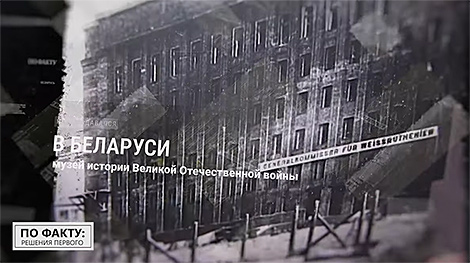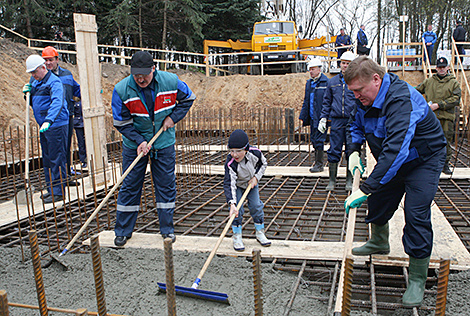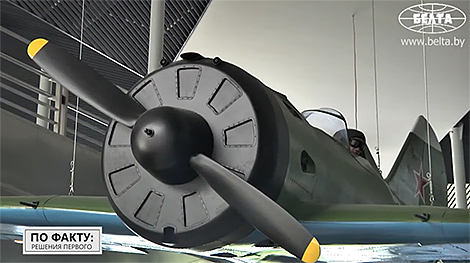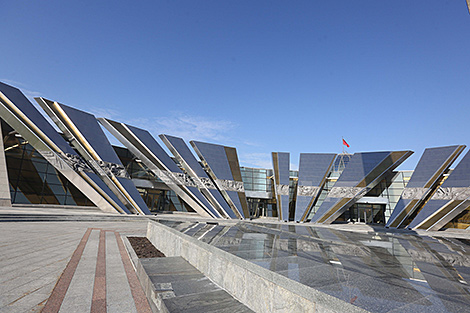News & Events in Belarus
‘Europe should remember and value this!’ Lukashenko’s ‘untrendy’ decision to keep WW2 memory alive

Today, there are about 9,000 monuments and memorials commemorating the Great Patriotic War in Belarus. The country is rightfully proud of the fact that none of them has been destroyed, desecrated or abandoned. In the new episode of BelTA’s YouTube project “After the Fact: Lukashenko’s Decisions” we will tell you about a true temple of people's memory, whose mission is to convey the truth about the war to future generations. Judge for yourself. The Great Patriotic War Museum, which we will talk about, is the most popular museum in the country. It draws up to 500,000 domestic and foreign visitors. Official delegations visiting Belarus consider it their duty to visit the museum and see one of the largest collections of military history artifacts.
Belarus became the first country in the world to create a museum of the Great Patriotic War. Why is it considered unique in the entire post-Soviet space today? What "untrendy" decisions did the president make to help Belarusians preserve their heritage, and what, according to Aleksandr Lukashenko, should Western Europe remember and appreciate, and? Let’s go.
When was the museum set up?
1942. The height of the Great Patriotic War. The Central Committee of the Communist Party of the BSSR made an unusual decision: to set up a republican commission to collect documents and materials about the war. Radiograms with orders were sent out to partisan brigades, and partisans, risking their lives, collected and buried future exhibits in the ground in cartridge boxes.
In November 1942, residents of wartime Moscow witnessed an impressive exhibition titled "Belarus lives, Belarus fights, Belarus was and will be Soviet." The exhibition opened at the State Historical Museum on Red Square and featured more than 300 exhibits: documents, photographs, works of art, and clothing items. A year later, a decision was made to create a museum of the history of the struggle of the Belarusian people against the German occupiers. Just imagine how strong and unshakable was people's faith in the victory.
"This decision says a lot. Even then, in the summer of 1942, people lived and believed in the victory, although, as we know, things were quite difficult and tense at the fronts. In the occupied territory of our country, the partisan movement and underground struggle were still gaining strength and scope. But nevertheless, people's faith in victory was very strong," said Svetlana Pribysh, deputy chief custodian of the museum.

What is on display in the Great Patriotic War museum?
On 16 July 1944, a parade of partisans took place in Minsk, and a few days later they laid up arms and took up the trades of masons, plasterers, and painters. A few months later, the Great Patriotic War Museum was solemnly opened in the capital.
It ran two expositions: "Armament of Belarusian partisans" and "Bolshevik press of the BSSR during the Great Patriotic War" spanning 25 halls.
“There was simply no stone left from pre-war Minsk: piles of bricks, ruins. But that building miraculously survived, and our museum was lucky to have its first exposition opened there. The first employees were the partisans, underground fighters, who fought the enemy literally the day before. It was not easy for them. If you look at one of the photos, you see the first museum workers standing near the first exposition that was still being mounted, and some of them were barefoot. They did not have anything to put on. At the same time, their faces are inspired and happy. Because people survived the war and understood the real value of life," Svetlana Pribysh said.

Why was a new building built for the new museum?
The museum continuously grew and had to move several times. In 1966, it moved to a building in Tsentralnaya (now Oktyabrskaya) Square. It was located there for almost half a century, until Belarusian President Aleksandr Lukashenko made a decision, an untrendy one as he himself described it, to build a new, majestic building of the museum.
It was not just about the catastrophic lack of space and the outdated building. “We will make this museum top-notch, so that visitors coming to Minsk will be able to get a very vivid picture of what our people went through in order to save them,” the head of state remarked. He went on saying: “Western Europe must remember and appreciate our fortitude and steadfastness that saved them from annihilation.”
“We can hold our heads up high, look any decent person in the eye. We did not mistreat those who fought in the Great Patriotic War. We took care of them, looked out for them and keep supporting them; there are not many of them left. We have not destroyed a single monument - on the contrary, we keep unveiling new ones. By Independence Day, we will commission a new building of the Museum of the Great Patriotic War History. No one in the world does this anymore. But young people should know that this is our victory and they should be proud that it was our parents and grandparents who saved Europe that now brags of its wealth. They would have perished if not for our feat. This is our great legacy, we must preserve it,” the head of state said during his trip to Klimovichi District, several months prior to the commissioning of the museum.
It was decided to build a new museum on Pobeditelei Avenue near the Minsk Hero City Stele. Its construction began in April 2010. The president of Belarus had a hand in the construction in the most literal sense of the word. During the national voluntary work day, Aleksandr Lukashenko took part in the construction and laid a time capsule with a message to descendants. The country had not known museum projects of such a scale before.

The new museum was inaugurated on 2 July 2014 - on the eve of the 70th anniversary of Belarus’ liberation from the Nazi invaders. Taking part in the ceremony was Vladimir Putin.
"We are deeply outraged by the blatant lies about the war. Various pseudo-historians present traitors as heroes and invaders as liberators, shamelessly rewrite the history for politically motivated reasons and try to take the Great Victory away from our people. We will continue to rebuff resolutely such ‘history looters’ and defend the most important historical heritage. In this war against ‘looters’, we will stand together too,” the Belarusian leader said back then.

The Russian president, in turn, noted that the new museum building is a true monument to the immortal feat of all who fought against fascism. “The museum's exhibits will undoubtedly contribute to educating the younger generation and encourage them to look up to the true heroes who defended their homeland, freedom and independence,” said Vladimir Putin.
What to see in the Great Patriotic War Museum
The building is stately and very impressive. It was built in the form of a semicircle on a hill near the Minsk Hero City Stele together with which it forms Heroes’ Square. The building consists of four blocks, symbolizing the four years of the war. The blocks are linked by the gallery Road of War. The central façade is designed as a symbolic Victory Salute, with its rays symbolizing ten significant events - from the defense of the Brest Fortress to the hoisting of the Victory Banner over the Reichstag.
The total area of the museum exceeds 15,000 square meters. The exposition was arranged on four floors in eleven halls with a total area of over 4,000 square meters. It displays 8,000 museum items and scientific and auxiliary materials dedicated to three periods: the eve of the Great Patriotic War, the war years and the post-war period.
The chronological framework of the exhibition was expanded to show what led to the Second World War and how the country was rebuilt in the first post-war years. The latter segment shows the incredible effort the Belarusian people put into raising the country from ruins and bringing it back to life in the shortest possible time.

Most valuable items of the museum
The Great Patriotic War Museum boasts the country’s largest collection of military history items. Its funds contain 164,000 items, including photographs, documents, letters, personal belongings of front-line soldiers and officers, partisans and underground fighters. Of particular importance are the collections of handwritten partisan journals and improvised weapons. The journals are valuable chronicles of the Belarusian life, while each item of improvised weapons shows great ingenuity of partisan gunsmiths.
In the run-up to the 80th anniversary of the museum, its employees tried to recreate the first exhibition and displayed items that were shown to visitors in 1944.
“When our museum opened in Minsk back in 1944, its holdings contained about 10,000 items. Our first visitors saw two expositions: one about the Bolshevik wartime press and the other about weapons of Belarusian partisans, including unique improvised arms. Not only could partisan gunsmiths fix damaged or broken weapons, they were so talented that they could craft their own weapons,” said Svetlana Pribysh.
There are also exhibits that have never left the permanent exposition. When the clearing of the Brest Fortress began in 1949, museum employees were also present at the site. The remains of a man in a half-decayed service shirt were found among the ruins. They found a Komsomol ticket in the pocket. It belonged to lieutenant Aleksei Naganov. The uniform was brought to Minsk in a terrible condition. The relic was soon sent to Moscow for restoration. Once back to Minsk, Naganov's uniform was made part of the exposition, and has never left it since then.
There is another item from the Brest Fortress - a fragment of the wall with the inscription of the defenders. It is a historical and cultural value of Belarus.
“On average, the funds of our museum are replenished by 1,200 units every year. These are museum objects, scientific and auxiliary materials. The sources are different, but first of all these are personal archives. The museum also works with various state and public organizations, which contribute to the replenishment of the funds”, Svetlana Pribysh said.
One of the valuable relics is a 45mm anti-tank gun and a GAZ-AA truck. The 45mm gun, which was used in battles against the Nazis, was showcased during the partisans’ parade in Minsk on 17 July 1944. Then the partisans of the Pravda Newspaper detachment donated it to the museum. The gun is kept in the museum’s largest hall Road of War.
Pavel Mikhailov, a native of the village of Belyany, Vitebsk Oblast, took part in the battles near Moscow, evacuated children from Leningrad across the ice of Lake Ladoga and also fought in Berlin. Pavel Mikhailov was wounded twice. In peacetime he drove the same truck until his retirement.
“Everything here is a reminder of the price we paid to preserve ourselves as a nation, to defend our right to live on this land and rebuild our state. Being in this temple of mourning for the millions of victims and pride in the generation of victors, I have only one question. Has the war taught people anything? It would seem that the memory of those terrible, relatively recent events is still fresh. After all, witnesses of Nazi atrocities are still among us. This national memory should have cooled down the ardor of individual politicians and figures. But what do we see? The number and scale of challenges and threats are not decreasing. As a result of inter-ethnic and intra-ethnic wars, people continue to die, and they die in masses. Modern revanchists provoke new conflicts. To justify themselves, they are trying hard to rewrite the history and take the Victory away from the Soviet people, and call the heirs of the victors, i.e. us, the aggressors. We cannot let it happen,” Aleksandr Lukashenko said as he presented state awards and the Banner of the Prosecutor's Office of the Republic of Belarus in 2022.
Museum mobile expositions
In the post-war years, the museum employees were not only actively working on the exposition but were engaged in scientific and educational work. Apart from traditional excursions around the museum, they organized lectures at the enterprises and institutions of Minsk, excursions to the places of military glory, and developed mobile thematic exhibitions. This tradition continues today.
A few years ago a mobile exposition was developed to travel around the Belarusian cities. It was a tribute to the memory of the dead and gratitude to the surviving veterans. It was also a call and appeal to the younger generations of the winners to be proud of their country and be grateful to its heroes.
In 2018, the Belarusian Telegraph Agency BelTA and the Great Patriotic War Museum launched a joint project “Partisan Chronicle” dedicated to the 75th anniversary of the liberation of the country from the Nazis. The project tells about the Belarusian partisans during the Great Patriotic War. The project in six languages is based on a unique collection of handwritten partisan journals, which have the status of historical and cultural value of Category 1 of international importance.
Why is the Great Patriotic War Museum unique?
Vladimir Voropayev, Director of the Great Patriotic War Museum, emphasizes that the uniqueness of the museum lies in the deep reflection of the national memory.
“For 80 years the museum has been fulfilling the high mission of preserving cultural and historical heritage, which supports and guides people in moving towards a bright future. Throughout all these years, the research, exposition, cultural and educational activities of the museum contribute to the formation of patriotic consciousness of young people and continuity of generations. Our doors are always open for those who are interested in the history of the Great Patriotic War. Here, in an atmosphere of reverence for the heroic deeds of our fathers and grandfathers, you can touch the authentic evidence of that era, feel the connection of times and learn the value of peace,” Vladimir Voropayev said.

Today the Great Patriotic War Museum is rightfully considered the national treasure trove of the country. It keeps the memory of irreparable losses and incredible difficulties that the Belarusian people had to suffer during the war. Belarus is doing and will continue to do everything possible to ensure that new generations keep the memory of the true heroes of the war.







 print version
print version make home page
make home page add to bookmarks
add to bookmarks

